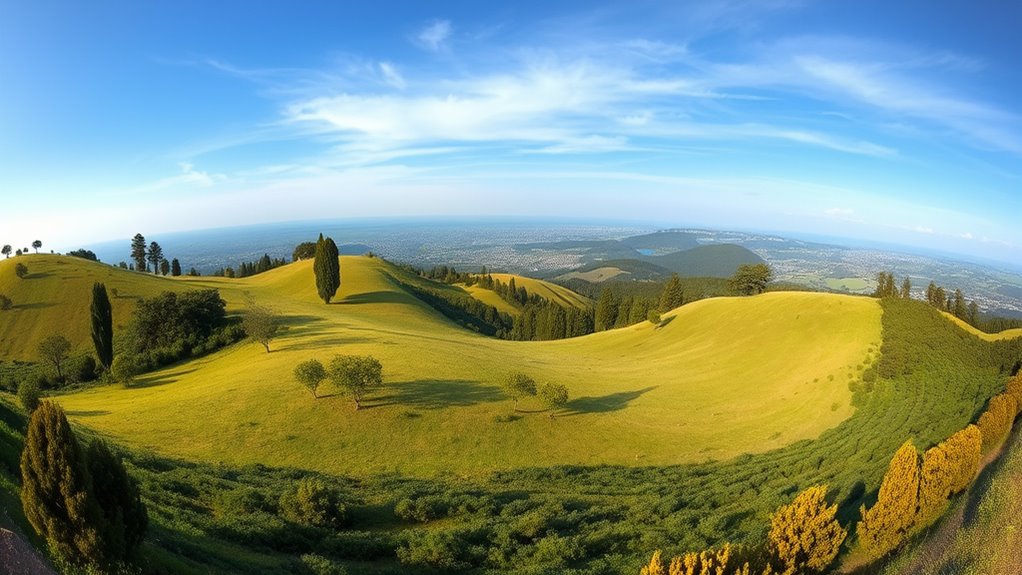When selecting a site, focus on natural features like wind and sun exposure, which can boost your sustainability efforts and reduce energy costs. Look for locations with strong prevailing winds to support wind energy projects, and sites with ample sunlight for solar panels. Plus, consider the views—scenic sites can attract customers and improve employee satisfaction. If you want to uncover more ways natural features can optimize your site choice, keep exploring these key factors.
Key Takeaways
- Optimal site selection considers natural views to enhance aesthetic appeal and customer experience.
- Locations with strong prevailing winds are ideal for wind energy generation and reducing energy costs.
- Sun-exposed areas support solar panel installation, promoting renewable energy use and sustainability.
- Combining scenic views with wind and sun resources can boost business reputation and environmental responsibility.
- Geographical features like open landscapes maximize natural light and wind access, improving operational efficiency.

Have you ever wondered how businesses decide where to set up shop? The process involves more than just finding a convenient location; it requires careful analysis of various factors like geographical considerations and environmental impact. These aspects are vital because they influence not only the operational efficiency but also the long-term sustainability of the business. When evaluating a site, you need to think about how the land’s features—such as terrain, proximity to transportation, and access to resources—will affect your operations. Geographical considerations can determine how easily your suppliers can deliver goods or how accessible your customers will be. For example, a location near major highways or ports might reduce transportation costs, boosting your bottom line. Conversely, you might want to avoid areas prone to natural disasters or with difficult terrain that could hinder movement and logistics. Incorporating natural elements into your site analysis can further enhance the sustainability and appeal of your location.
Environmental impact also plays a significant role in site selection. Today, businesses are increasingly aware of their ecological footprint, and choosing a site that minimizes environmental harm is often a priority. You should assess how your operations might affect local ecosystems, water sources, and air quality. For instance, setting up in a region with fragile habitats or wetlands could lead to regulatory issues and community opposition. Additionally, environmental considerations can influence your energy use and sustainability initiatives. An ideal site might have abundant natural resources, such as sunlight or wind, which can be harnessed to reduce energy costs or support renewable energy projects. This not only benefits the environment but can also enhance your company’s reputation as a responsible corporate citizen. Another key factor is how the site’s geographical features influence environmental impact. For example, a location with strong prevailing winds might be suitable for wind energy generation, which can serve as a sustainable power source. Similarly, land with good sun exposure could be ideal for solar panels, helping you cut energy expenses while reducing reliance on fossil fuels. These considerations can help you align your operational goals with environmental sustainability, making your business more resilient in the face of changing regulations and societal expectations.
Frequently Asked Questions
How Does Local Wildlife Impact Site Selection?
You need to take into account local wildlife impacts on site selection because wildlife migration patterns and habitat preservation are vital. If your site disrupts migratory routes or damages habitats, it can harm ecosystems and lead to regulatory issues. By choosing locations that respect wildlife corridors and preserve habitats, you help maintain biodiversity and avoid conflicts. This proactive approach guarantees your project aligns with environmental conservation efforts and minimizes negative ecological effects.
Are There Legal Restrictions Based on Scenic Views?
You’ll find that scenic conservation efforts often influence site selection through viewpoint restrictions, protecting the natural beauty that inspires us. Laws may impose restrictions to preserve iconic vistas, ensuring they remain unspoiled for future generations. These legal measures aim to balance development with the community’s desire to maintain scenic charm. By respecting these regulations, you help safeguard breathtaking landscapes, fostering a sense of pride and connection to your environment.
Can Climate Change Alter Optimal Site Conditions?
Yes, climate change can alter ideal site conditions, affecting your site’s resilience and requiring climate adaptation. Rising temperatures, shifting wind patterns, and changing sunlight exposure can make previous perfect locations less suitable. You need to reassess your site regularly, considering future climate impacts, to guarantee long-term resilience. By adapting your site selection strategies now, you can better withstand climate-related challenges and maintain your project’s effectiveness over time.
How Do Cultural or Historical Sites Influence Location Choices?
You realize that cultural and historical sites are like priceless treasures guiding your location choices. You prioritize heritage preservation and consider how tourism impact can either boost or harm these sites. By carefully selecting locations that respect history, you protect their integrity while attracting visitors. Your goal is to balance development with preservation, ensuring these iconic landmarks remain vibrant and meaningful for generations to come.
What Are the Long-Term Maintenance Considerations for Wind and Solar Sites?
You need to plan for long-term maintenance by establishing regular maintenance schedules to guarantee peak equipment performance. Focus on monitoring equipment durability, as wind turbines and solar panels face wear from weather and operational stress. Address issues promptly to prevent costly repairs or downtime. Proper upkeep extends the lifespan of your systems, maximizes energy output, and reduces unexpected expenses over time. Staying proactive with maintenance keeps your renewable energy site efficient and reliable.
Conclusion
When choosing a site, remember that subtle factors like gentle breezes and warm sunlight can quietly shape your success. By paying close attention to the views, wind, and sun, you’re gently guiding your project toward harmony with nature’s quiet blessings. Sometimes, the most unassuming choices hold the greatest promise. Trust your instincts, embrace the subtle clues, and let the natural environment softly steer you toward a brighter, more sustainable future.









